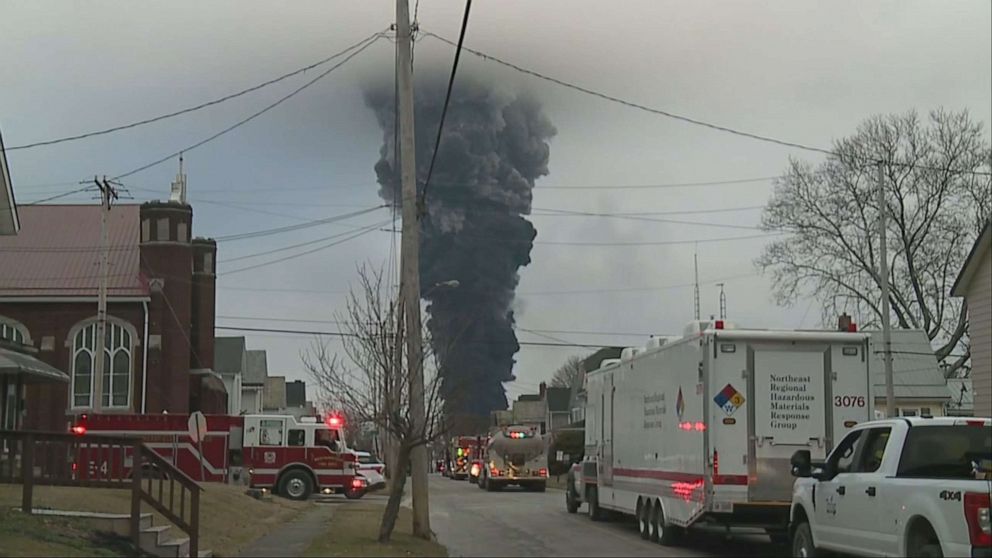Ohio Train Derailment: The Prolonged Presence Of Toxic Chemicals In Buildings

Table of Contents
Contamination Pathways: How Toxic Chemicals Entered Buildings
The release of toxic chemicals from the derailed train presented multiple pathways for contamination to infiltrate nearby buildings. Understanding these pathways is crucial to assessing the extent of the problem and developing effective remediation strategies.
-
Airborne Dispersion: Volatile organic compounds (VOCs), such as vinyl chloride and butyl acrylate, are known for their volatility. These chemicals could have easily entered buildings through open windows, inadequately sealed doors, and even through cracks in walls and foundations. Building ventilation systems, meant to provide fresh air, could have inadvertently drawn contaminated air inside, exposing occupants to potentially harmful levels of VOCs.
-
Surface Contamination: Chemical residue from the derailment could have attached to clothing, shoes, and even the fur of pets. People and animals moving through the affected area unknowingly carried these contaminants into their homes and businesses, resulting in surface contamination on floors, furniture, and other surfaces. This indirect pathway of contamination highlights the widespread nature of the problem.
-
Water Contamination: The possibility of groundwater and surface water contamination poses another significant concern. Chemicals released during the derailment could have leached into the soil, contaminating local water sources. This contaminated water could then enter buildings through plumbing systems, leading to further exposure risks. Flooding, even minor incidents, could also spread contaminated water and sediment throughout buildings.
Types of Toxic Chemicals and Their Long-Term Effects
The Ohio train derailment released a cocktail of hazardous chemicals, many with serious and long-lasting health consequences. Understanding the specific chemicals and their associated health risks is paramount for effective risk assessment and management.
-
Vinyl Chloride: Known to be a potent carcinogen, vinyl chloride exposure can lead to an increased risk of several cancers, including liver cancer, brain cancer, and lung cancer. Long-term exposure can also cause liver damage and other serious health problems.
-
Butyl Acrylate: This chemical is an irritant that can cause respiratory problems, skin irritation, and eye irritation upon exposure. Long-term effects are less well understood but may include chronic respiratory issues and other systemic health problems.
The long-term health effects associated with exposure to these chemicals can be significant and include:
- Respiratory Problems: From shortness of breath and coughing to chronic obstructive pulmonary disease (COPD) and asthma.
- Cancer Risks: Increased risk of various cancers depending on the specific chemical and duration of exposure.
- Neurological Damage: Potential for cognitive impairment, neurological disorders, and other central nervous system effects.
- Reproductive Issues: Concerns about potential impacts on fertility and developmental problems in offspring.
Testing and Remediation Efforts: Addressing Building Contamination
Testing buildings for contamination after the Ohio train derailment presents significant challenges. The sheer volume of affected properties and the diverse pathways of contamination require a comprehensive approach.
Common testing methods include:
- Air Sampling: Measuring the concentration of VOCs and other airborne contaminants inside buildings.
- Surface Wipe Sampling: Collecting samples from surfaces to analyze for the presence of chemical residue.
Remediation processes, if and when undertaken, are complex and expensive, often involving:
- Decontamination: Thorough cleaning and removal of contaminated materials.
- Ventilation: Improving building ventilation to remove airborne contaminants.
- Repair or Replacement: Repairing or replacing damaged building components.
The cost associated with these efforts can be substantial, adding further burden to affected homeowners and businesses.
Government Response and Community Concerns
The government's response to the Ohio train derailment and subsequent building contamination has been a focus of intense scrutiny. Investigations are ongoing to determine the full extent of the damage and to hold responsible parties accountable.
Community concerns are primarily focused on:
- Long-term health risks: Residents fear the long-term health effects of exposure to toxic chemicals.
- Property values: Concerns about the impact of contamination on property values and the ability to sell homes or businesses.
Legal action and compensation claims are expected to arise from the incident as affected individuals seek redress for their losses and health concerns.
Conclusion: Understanding the Long-Term Impact of the Ohio Train Derailment on Buildings
The Ohio train derailment has underscored the prolonged and far-reaching consequences of releasing toxic chemicals into the environment. The contamination of buildings presents a significant and ongoing challenge, requiring sustained monitoring, thorough testing, and, where necessary, effective remediation. The long-term health risks associated with exposure to these chemicals are a serious concern that demands a comprehensive and proactive response.
It is crucial to remain informed about the latest developments concerning the Ohio train derailment and the efforts to address building contamination. Contact your local authorities for information on testing and remediation programs. Understanding the risks and taking proactive steps are vital for protecting your health and the health of your community in the wake of this environmental disaster. Continued vigilance and a concerted effort toward effective Ohio train derailment toxic chemical cleanup are essential for mitigating the long-term health risks.

Featured Posts
-
 Deutschland Beim Esc Wiener Duo Abor And Tynna Im Fokus
May 04, 2025
Deutschland Beim Esc Wiener Duo Abor And Tynna Im Fokus
May 04, 2025 -
 Ufc 313 Predictions Expert Analysis And Betting Odds
May 04, 2025
Ufc 313 Predictions Expert Analysis And Betting Odds
May 04, 2025 -
 Tioga Downs Prepares For Its 2025 Racing Season
May 04, 2025
Tioga Downs Prepares For Its 2025 Racing Season
May 04, 2025 -
 Ufc 314 Fan Favorite Knockout Artists Fight Cancelled
May 04, 2025
Ufc 314 Fan Favorite Knockout Artists Fight Cancelled
May 04, 2025 -
 Corinthians Vs Internacional Transmissao Ao Vivo Horario E Provaveis Times
May 04, 2025
Corinthians Vs Internacional Transmissao Ao Vivo Horario E Provaveis Times
May 04, 2025
